ABSTRACT
As part of a programme to use the latest technologies and then optimise their use to deliver significant improvements, Shell has upgraded the protection and prediction systems on the Shell Draugen oil and gas platform in the North Sea. These new systems, have been installed to monitor and protect key platform equipment, helping to improve maintenance efficiency and increase production.
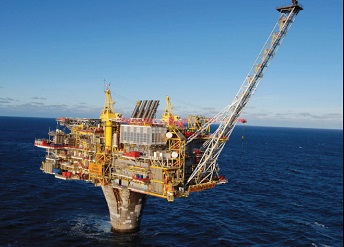
Shell aims to perform 40% of its offshore maintenance workload on the Draugen platform (see Figure 1) with prediction-based maintenance. Monitoring equipment accurately and identifying potential problems early helps prevent key assets from failing unexpectedly, reducing costly production downtime. This results in an increase in overall production and an improvement in maintenance efficiency. Shell embraced both protection and machinery health management systems many years ago, but are now transitioning from an obsolete system to newer technology that will deliver improved performance benefits. For example, the company is now able to integrate data from remote and stand-alone on-line machinery health monitoring systems directly into the ‘Shell Smart Connect’ global asset monitoring system. By providing open global access this has enabled Shell to efficiently review data, compare data from other platforms and determine best practice solutions to potential problems.
Integration with the Shell Connect network was a major consideration when the company embarked on the upgrade project for its Draugen oil and gas platform in the North Sea. Draugen is Shell’s northernmost operative field, with the platform processing around 40,000 bpd recovered from five platform wells and six sub-sea wells. The platform’s existing protection and prediction monitoring systems were installed in 1993 and the company was now having difficulty obtaining support and spare parts for systems that had become obsolete. There was therefore a need to replace the existing systems to ensure they would have continual life-cycle support. The upgrade would also provide Shell with an opportunity to revert to a single solution provider and to standardise on just one system. This would help to streamline inventory and simplify training programmes. Added to this would be access to the latest technology currently available on the market, with benefits such as transient analysis for monitoring multiple channels simultaneously, and access to continuous streams of recorded data to assess previous events.
Shell System for Monitoring Rotating Equipment
The upgraded on-line machinery protection and prediction systems selected were provided by Emerson Process Management. Critical in this selection was these systems’ ability to easily deliver both process and machinery health information, using OPC, into the office domain for analysis. The Shell Smart Connect system is used to provide an overall picture of the health of assets from sources globally – in a common manner to those that need it. Data from the prediction system was also required to be sent to a data historian, enabling tasks such as trending to be performed in the office domain. Shell’s vision is to make as much asset monitoring data available at the office level as possible, making it easily accessible to any authorised person in any location.
Another important factor was that the system had to be flexible and open to enable connection to the majority of the existing proximity probes. This would prevent the need to replace the probes, limiting any potential disturbance to production.
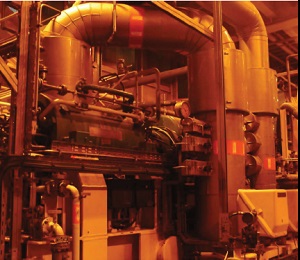
The on line machinery monitoring solution was deployed to monitor and protect the power turbines, condensate pumps, crude oil booster and loading pumps, the booster and gas compressors (see Figure 2), fire/sea water pump, water injection booster pump, PWRI (Produced water re-injection) booster pump, and two tornado-driven water injection skids. Protection and prediction systems are kept separate to meet IP670 requirements, but share the same signals from the probes. The scope of the project also included the use of Emerson’s AMS Suite: Machinery Health Manager, which collects data from the protection and predictionsystem and presents it, via a common software user interface, to operators.
A portable vibration collector is also used to collect additional offline route-based data. This enables less critical devices, which do not have continuous vibration measurements in place, to be monitored. By regularly collecting vibration data, which is then downloaded and analysed using AMS Machinery Manager, the health of these devices can be presented within the Shell Smart Connect system.
In total, over 250 sensors provide up to 2000 vibration values (indicators of the health of the equipment) which are processed by the machinery protection and prediction systems. Through analysis of the vibration data any potential problems are instantly identified and the system is able to pinpoint the exact cause. This could include shaft imbalance or misalignment, or bearing defects caused by wear.
Shell worked closely with Emerson to implement the new systems. As was expected, the upgrade of the twenty- year-old systems did raise some issues. For example, there were a few uncertainties regarding existing vibration set points and voting. Also, evaluating the existing prediction and protection system equipment was difficult because there was a lack of documentation related to vibration signal filtering and trip multiply settings. The evaluation was made more difficult because some of the LED status indicators were no longer working on the units. This lack of documentation provided another rationale to upgrade. The experience of the new systems’ provider was critical in overcoming these problems, despite the existing system being from a different supplier.
Installation had to take place offshore, while equipment such as the gas compressor train and three 15MW turbines had to remain in service. New cabinets, which had been pre-wired onshore, replaced the existing cabinets, making installation easier and faster. The limited availability of sleeping accommodation on the platform meant it was difficult to fly a team out and then spend a lot of time engineering the solution on the platform. This limitation also affected surveys, installation and commissioning. It also meant that any future updates to the monitoring systems would preferably need to be completed remotely.
Compressor Balance
When evaluating a system for the upgrade, the software element of the solution chosen was where it gained a clear advantage. The system collects and stores vibration data, before its AMS Machinery Manager software provides the user with a wealth of processed and analysed information that highlights potential problems. Overall vibration trends, orbits, shaft centre-line, Bode/Nyquist, cascade, waveform, and spectrum can be viewed for a detailed diagnosis of the equipment’s health. The system’s unique ability to provide orbit shaft rotation has already proved to be extremely useful for assessing the dynamics of machinery malfunctions, and how they can accurately identify failures such as imbalance or rub.
On the protection side, the system records up to 100 hours from all channels on to a hard disk, which can be replayed should an event occur (see Figure 3). This can be used to help us understand what caused the event and how best to fix the problem. The transient facility also supports the prediction system. By analysing the data it is possible to see where adjustments can be made to measurement parameters to obtain more precise information. These can be adjusted (fine-tuned) remotely and while the equipment is in live mode, once again preventing the need to disturb production.
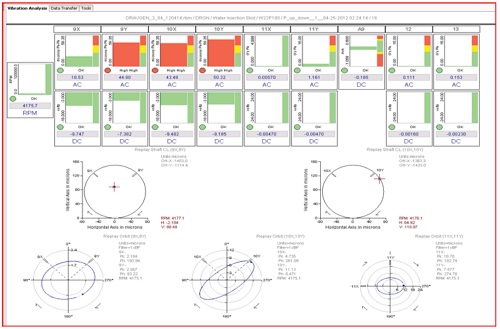
The new prediction system has proved to be extremely powerful, for not only identifying potential machinery health problems, but also for helping to correct them. For example, following safety advice from the manufacturer, we had to install new seals on a gas compressor during a planned shutdown. Following the change, compressor stability was upset and we started to incur problems. The new monitoring system immediately identified an increase in vibration levels from the drive end of the compressor during start-up. Using the system it was possible to deduce that there was imbalance near the centre of the shaft, which needed to be addressed quickly.
To pinpoint the fault we changed the speed of the compressor up and down and, by using the transient data facility in AMS Machinery Manager, operators were able to quickly identify the heavy spot to enable re-balancing (see Figure 4). The use of the transient data reduced the number of starts and stops needed to pinpoint the exact point in the shaft to add weight. This significantly reduced the time the compressor was offline. Having evaluated the data from the gas compressor, an overhaul and balance check/correction was scheduled during a short shutdown. The data from hot shutdowns enabled the engineers to be well prepared and confident of placing the right weight in the right position. Having this information in advance saved an estimated 1.5 days of compressor downtime, amounting to around 60,000 barrels of oil. The compressor has been stable ever since, with vibration levels reduced to levels lower than before the change to the seals. This indicates improved balancing that will reduce any stresses on the equipment and extend the period between required maintenance.
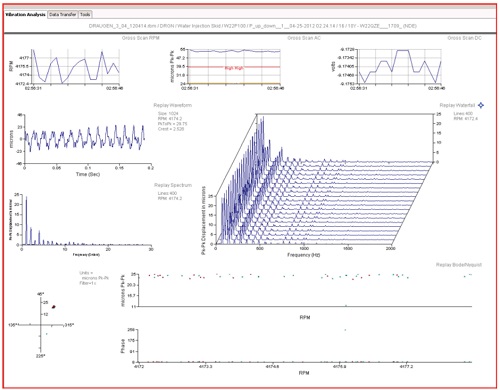
Vibration Probe Verification
After twenty years of service some of the existing probes were starting to become problematic and were in need of an overhaul. Using the AMS Machinery Manager software it was possible to determine which probes were working correctly and which were producing spurious signals and needed attention. Operators could view the vibration spectrum within the software and identify any degradation of signal. Discovering problematic probes helped prevent false readings, which could result in unnecessary trips or rises in vibration going unnoticed.
Further improvements are anticipated. Shell is embracing the additional functionality provided by the upgraded systems, such as Live Mode, and transient archiving. The live mode in AMS Machinery Manager provides real-time data plots, including overall levels, orbits, shaft centre line, Bode/Nyquist, cascade, waveform, and spectrum (see Figure 5). This enables operators and experts situated remotely to make informed real-time decisions to bring a turbine up for critical production needs or to shut down to protect the asset. A key benefit of the new software is the ability to select and focus in on a particular element of the data in real-time. After an incident or failure takes place the automatically collected historical data is now carefully analysed onshore and then improvements are made by designing out the failure mechanism.
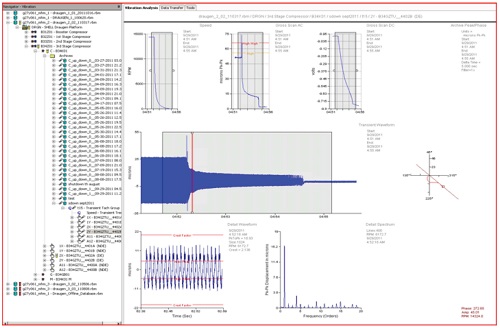
The benefits of the new protection and prediction systems are significant. Shell has ensured the installed systems are supported for the foreseeable future. Shell has been able to start the standardisation programme and will shortly start to benefit from a reduction in inventory and streamlined training procedures. The integration of analysed vibration data from the machinery protection and prediction systems into the Shell Smart Connect system has enabled access to this information by experts located anywhere in the world. This is helping Shell to detect problems earlier and rectify them before production is interrupted. The investment in the prediction and protection system upgrade has been already covered by the savings made by a more efficient maintenance programme and the reduced downtime needed to correct the compressor balancing problem.

